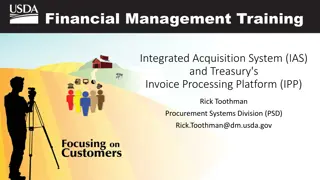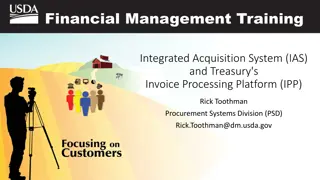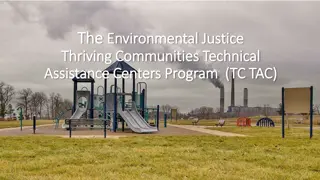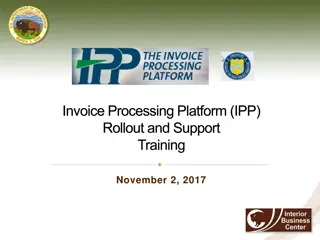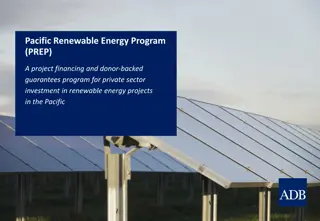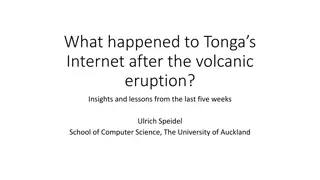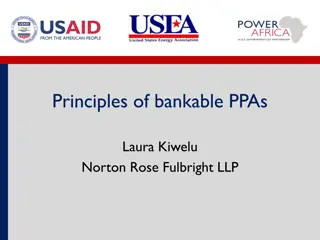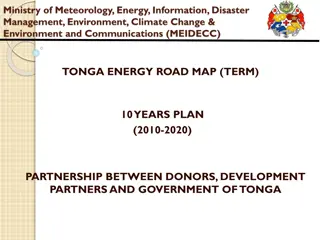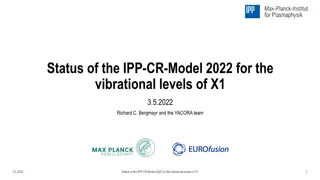Strengthening Tonga's Power Sector: Technical Assistance and IPP/PPA Training Program
Strengthen the capacity of the Tonga Electricity Commission in promoting private sector investments in the power sector through technical assistance and a training program led by Dr. Viren Ajodhia. The program covers the role of Independent Power Producers (IPPs), Power Purchase Agreements (PPA) process, basics, and advantages, emphasizing the need for IPPs to meet electricity demand, attract investments, and promote renewable energy technologies.
Download Presentation

Please find below an Image/Link to download the presentation.
The content on the website is provided AS IS for your information and personal use only. It may not be sold, licensed, or shared on other websites without obtaining consent from the author.If you encounter any issues during the download, it is possible that the publisher has removed the file from their server.
You are allowed to download the files provided on this website for personal or commercial use, subject to the condition that they are used lawfully. All files are the property of their respective owners.
The content on the website is provided AS IS for your information and personal use only. It may not be sold, licensed, or shared on other websites without obtaining consent from the author.
E N D
Presentation Transcript
Technical Assistance to strengthen the capacity of the Tonga Electricity Commission in promoting private sector investments in Tonga s Power Sector Pacific Community (SPC) Tonga Electricity Commission (TEC) Training Program by Dr. Viren Ajodhia IPPs and PPAs Thursday 13 August 2020
Program 1. Role of the IPP 2. IPP/PPA process 3. PPA Basics 4. PPA and RE technologies 5. PPA Tariff
Why an Independent Power Producer? Growth in electricity demand and aging capacity Requirement of new investments in power generation Public finance for power investments is not generally available Challenges and risks of technologies that are relatively new Governments seek for competition in power production New generation investments by Independent Power Producers (IPPs) with Power Purchase Agreement (PPAs) Utility should remain responsible for generation expansion planning and keeping up reserve capacity
Power Purchase Agreement (PPA) A PPA is a legal contract between an electricity generator (seller) and a power purchaser (buyer). During the period of the contract the power purchaser buys electrical energy, and sometimes capacity, from the electricity generator. The Seller (IPP) is (often) the developer, owner and operator of the technology that generates electricity. The Buyer is (often) a utility company that purchases the electricity generated from the seller. Dependent on the type of (renewable) technology utilized for power generation, PPAs need to be tailored to relevant requirements and specific issues.
Long term relationship In the PPA a long-term relationship between the utility and the IPP will be created (15 or 20 years up to 25) For the IPP a long-term stream of revenues is necessary for securing the financing and the rate of return For the utility the delivery of a defined amount of electrical energy has been secured In the case of renewable energy a step has been made towards achieving goals on the targets as set for renewable energy and reduction of the usage of fossil fuels
Advantages Encourage and attract private investment Injection of new foreign capital (FDI) in the country Transfer of technology and know-how Completion of project within time frame and budget
Project structure Government Concession agreement sharing risks Lenders Debt repay Debt PROJECT Limited equity Equity Construction costs Contractor Dividends Investors Billing Revenue Off-takers
Models BOT: BOOT: BOO: Build Operate and Transfer Build Own Operate and Transfer Build Own Operate
Build Operate and Transfer Government grants a concession (right to build, own and operate the facility) to a sponsor Government grants a long term lease or sell the site to the sponsor (provision of land) Often acquire most or all of the service provided by the facility Facility will be often transferred to the government/public sector at the end of the concession period without remuneration
Build Own Operate and Transfer BOOT differs from BOT in that the private entity owns the facility BOOT project is when a government grants a private-sector organisation a concession to build a facility, own it, operate it during the concession period, and then transfer it back to government.
Build Own Operate Ownership of the facility remains at the private company (shareholders) Residual value of the facility remains at the private company A BOO scheme might provide more incentive for the project sponsors to maintain the facilities during the concession period
Program 1. Role of the IPP 2. IPP/PPA process 3. PPA Basics 4. PPA and RE technologies 5. PPA Tariff
General process Construction completed Planning PPA signing Legal framework Policy framework Capacity needs identified Projects identified (MW/Technology) Permits and licences PPA as collateral Commercial Operating Date Start production and invoicing General principles Energy mix targets Competitive bidding (int l) Evaluate/Select Construction start Tests successful Regulatory Framework Financial clearance Tendering IPP Operations
Tendering process Regulatory Framework PPA selection guidelines Issued by Buyer Approved by Regulator Size, technology, location, interconnection Definition of project Competitive process International announcement Organisation of bidding Technical criteria Price criteria Evaluation of bids Approval by Regulator Selection of winning bid PPA signing
Typical PPA Main body Core of the legal agreement Schedules Technical details and parameters
Scope and Term Scope Seller shall design, procure, alter, finance, commision,test, operate and maintain a power plant, interconnection equipment and metering equipment Buyer shall purchase and pay for the electrical output Buyer shall design, procure, finance, test ,operate, maintain network from point of delivery to transmission line Term Duration will be 20-30 years Option for extension
PPA Main articles Definitions Scope and Term Conditions precedent Development stage Construction period Commissioning and Entry into commercial service, Plant operation and maintenance Measurement of capacity, availability and energy metering Capacity charge and payment provisions Fuel price provisions (if needed) Billing procedures, terms of payment Insurance Changes in tax, changes in law Force Majeure Termination and buy out provisions Governing law/dispute resolution Liability and indemnity Confidentiality Representations/warranties/covenants Miscellaneous
Schedules in PPA Description of Power Station/Facility Technical limits and guarantee values Development milestones Interconnection and transmission facilities Commissioning and testing Metering standards and testing Dispatch procedures Tariffs and billing
Program 1. Role of the IPP 2. IPP/PPA process 3. PPA Basics 4. PPA and RE technologies 5. PPA Tariff
From Financial Close to Construction Complete Financial Close Seller appoints Independent Engineer for monitoring Seller appoints EPC contractor Construction of facility Construction complete
From Construction Complete to Operations Construction complete Performance & Reliability test completed Net capacity equal or greater than guaranteed capacity Buyer accepts test reports Commercial Operations Data (COD)
Pre-Operation Obligations Operating procedures Energy before commissioning Upon Sellers request Buyer shall provide energy for construction, testing, start-ups and emergencies. Seller shall pay for the energy (tariff rate for industrial facilities) Energy produced during testing of the Facility shall be paid by Buyer Buyer will have access to the Facilities to observe construction progress of
Development & Construction (1) (Responsibility of Seller) Seller shall design, construct, install, commissioning, operate and maintain the power plant in accordance With the specifications Capacity at reference conditions, performance curves, partial load curves, losses Design data Telecommunication and interface with control centre of Buyer Power station electrical system, control system and protection system Circuit breakers and transformers Civil works and fencing
Development & Construction (2) (Responsibility of Seller) Reliability and availability Codes and standards Operation requirements Design limits Environmental requirements Security and safety Seller is responsible for Permits and licenses Credits, grants, loans Buyer shall assist Seller
Transmission and distribution Responsibilty of Buyer Design, construction, installation, commissioning operate and maintain transmission and distribution lines of transmission of agreed amount of power connection of delivery point to transmission grid
Construction-Interconnection Responsibility of Seller Design, construction, installation, commissioning, operate and maintain interconnection equipment for the transmission of the power Interconnection equipment must be able to transmit the agreed amount of power Switchgear,power transformers, interconnection lines Buildings grounding system, data transfer and communication Interconnection protection and control
Metering Off-Taker Facility Connection Point Distribution/ consumption Generation Net eletrical output MWh's reading Net electrical received MWh's Meter
Commissioning and Testing Performance testing-compliance with minimum performance guarantees and minimum requirements capacity, efficiency (heat rate), net electrical output at different load factors Reliability test to demonstrate that the unit is operating reliable and consistently (cold/hot start, full load operation etc.) Initial and Annual Dependable Capacity test Net Electrical Energy Output has to be measured during the tests
Operation and Maintenance Seller and Buyer shall jointly develop operating procedures before COD of the Facility Compliant with dispatch procedures Compliant with functional specifications Day-to day communication about available capacity and dispatch Minimum performance of Seller Dependable Capacity Minimum Annual Net Energy Output (MWh) Long Term Service Agreement
Scheduling and Dispatch Month Ahead Notification (14 days before beginning of each month) Day by day basis of Net Electrical Output Week Ahead Notification ( 48 hours before beginning of the week) Hour-by hour basis for Net Electrical Output Day Ahead Notification (7 hours before start of the day) Hour by hour basis for Net Electrical Output,start ups, reactive power requirements that day
Billing Procedure and Terms of Payment In the event of failure of metering, how the charge will be decided Penalty contemplated in the event of failure of payment and nature of securities/guarantees Obtained by Seller to secure their payment Letter of credit for specified amount tied to projected tariff payments for a specified period
Defaults and Termination (by Buyer) Termination by the Buyer for Seller s Default No Force Majeure or Buyer s default Failure to achieve Financial Closing Date or COD Failure to operate the facility without written consent of Buyer after COD Breach of Seller of any of its obligations under the PPA Abandonment of the Facility without written consent of Buyer In case of bankruptcy, insolvency, winding up or liquidation Tampering or undertaking fraudulent action by Seller on interconnection and electrical metering equipment
Force Majeure Means any act, event or circumstance or any combination of acts, events or circumstances which: beyond the reasonable control of the affected party without fault or negligence on the part of the affected party
Dispute resolution Dispute resolution by mutual discussions Dispute resolution through a Panel consisting of one or two high level representative(s)-Technical And/or dispute resolution submitted to arbitration according to UNCITRAL Rules or to the jurisdiction of a competent Court
Governing Law PPA shall be governed by and construed in acccordance with laws of . Mostly country of operation of Buyer Change in law includes amendment, modification of any applicable law and its impact on the tariff should adressed in the PPA. This implies an adjustment of the tariff must be possible (Pass-through)
Confidentiality Confidential information Each of the Parties and their contractors, consultants and agents shall hold in confidence all documents and other information relating to the design, construction, insurance, operation, maintenance, management and financing of the power plant
Program 1. Role of the IPP 2. IPP/PPA process 3. PPA Basics 4. PPA and RE technologies 5. PPA Tariff
PPA for Wind Power Agree upon an Annual Energy Amount based on the local wind regime as identified by measurements as used for the feasibility study Also erect at the wind farm site a wind measurement tower with appropriate height and calibrated anemometers, electronic recorder, wind data storage Generate a daily prediction of power output for each hour of the day
PPA for Wind Power (2) Technical means to be provided to utility (software, licenses) to be able to monitor and control the output of the wind park Utility should have the right to curtail the power output of the wind park up to a total amount of .. MWh s (to be agreed upon) over a .. year period without charges. If more power is curtailed the utility should pay for the difference. Administration of produced and curtailed power could be kept in the wind park SCADA system (which must also be accessible for utility). SCADA will also read data from billing meters
PPA for Wind Power (3) Include a power production table for a 12 months period under local conditions, including results of wind speed measurements with calibrated anemometers at a height of meters / ft Define the availability per windmill generator based on annual hours with wind speeds between a minimum and a maximum speed to be defined based on the wind turbine type
PPA for Wind Power (4) In case of high penetration additional measures must be taken into account based on dynamic simulations: Effect on system dynamic when adding wind to the generation mix Visualize impact of volatility on system control Assess opportunities for energy storage Impact of increasing spinning reserves Compare operation control strategies Identify more options in a smart grid context Investigate system response to outage or cable loss Test mitigation strategies for intermittent generation
PPA for Solar Power (1) Agree upon an Annual Energy Amount based on the yearly levels of irradiation as identified by measurements as used for the feasibility study Irradiation levels vary during the year Output can be volatile dependent on weather conditions and output predictions like for the wind speed are with a higher inaccuracy than wind speed predictions In case of storage (batteries) the output could determined at a more predictable level
PPA for Solar Power (2) Technical means to be provided to utility (software, licenses) to be able to monitor and control the output of the solar power park Agreements on curtailment of the power output, deemed generation and/or liquidated damages should also be worked out Administration of produced and curtailed power could be kept in the solar park SCADA system (which must also be accessible for utility). SCADA will also read data from billing meters Power quality requirements should also be set
Other renewable sources Biomass Generation with biomass for example by agricultural enterprises, selling on take or pay basis to the utility without much more requirements than what is technically and operational needed (including safety requirements) on both the facility and the utility side. On a larger scale terms on output and availability requirements are set. Sometimes biomass is season dependent. There are risks of biomass quality, water content, transportation to the generation facility.
Other renewable sources (2) A PPA for geothermal energy is based on the supply of Base Load to the utility (Take or pay) Energy amounts to be agreed upon Availability and maintenance schedules need to be defined sharply. Payment of deemed generation should by arranged for (in both ways) No intermittency characteristics Tariffs are based on a Capacity Charge and a price per kWh Power quality requirements to be defined
Other renewable sources (3) Waste to Energy Particular issues to be considered: Technological risks (proven technology) Environmental risks Waste quality risks Heating value (should be > 11 MJ/kg) Bottom ashes Waste supply throughout the year Financial risks Gate fee (or: tipping fee) - the charge levied upon a given quantity of waste received at a waste processing facility
Program 1. Role of the IPP 2. IPP/PPA process 3. PPA Basics 4. PPA and RE technologies 5. PPA Tariff
Pricing issues Average Cost Pricing Efficiency Incentives Capacity Pricing Availability Incentives
IPP Costs $ Total IPP Costs = Fixed costs + Initial Investment Variable costs kWh production
Optimal pricing Economic efficiency requires Price = Marginal Costs The IPP is providing two separate services kWh Electricity kW Capacity (availability) These should in principle also be priced separately Marginal cost of energy + Marginal cost of capacity But: Marginal cost of capacity =0 (as a function of kWh output) Only pricing at marginal cost would result in a financial loss => Not practical






